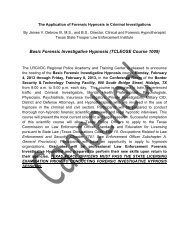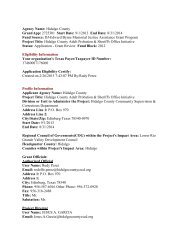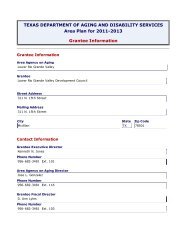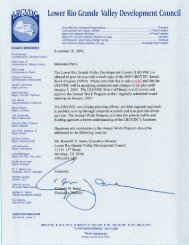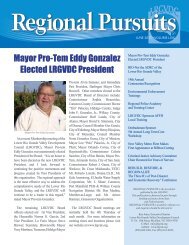Watershed Protection Plan - Lower Rio Grande Valley Development ...
Watershed Protection Plan - Lower Rio Grande Valley Development ...
Watershed Protection Plan - Lower Rio Grande Valley Development ...
Create successful ePaper yourself
Turn your PDF publications into a flip-book with our unique Google optimized e-Paper software.
ELEMENTS OF THE ARROYO COLORADO WATERSHED PROTECTION PLAN<br />
Prior to 2006, the standard operating procedures<br />
used for shipping by <strong>Rio</strong> <strong>Grande</strong> <strong>Valley</strong> Sugar<br />
Growers, Inc., the leading sugar processing company<br />
in the Arroyo Colorado watershed, included dumping<br />
truckloads of raw sugar onto the loading platforms<br />
at the Port of Harlingen and using front-end loaders<br />
(i.e., bulldozers) to load the sugar from the platforms<br />
onto barges for shipment north through the GIWW. At<br />
the end of each sugar loading operation, the loading<br />
platforms were sprayed with large fi re hoses and the<br />
excess sugar remaining on the platforms was washed<br />
directly into the Arroyo Colorado, increasing the loading<br />
of BOD into this portion of the stream.<br />
will continue to cause low DO in the Arroyo Colorado<br />
periodically despite improvement in water quality. The<br />
ACW Partnership has participated in discussions<br />
with individual stakeholders regarding artifi cial<br />
enhancement of aeration in the Zone of Impairment<br />
of the Arroyo Colorado using mechanical aerators or<br />
other engineering or structural controls. However,<br />
not much site-specifi c research has been conducted<br />
to date to assess the feasibility of these types of<br />
controls. Engineering controls for enhancing DO in the<br />
Arroyo Colorado remain an option for consideration in<br />
subsequent phases of the ACW <strong>Protection</strong> <strong>Plan</strong>.<br />
Top Strategies for Water<br />
Quality Improvement<br />
The ACW Partnership prioritized the strategies for<br />
improving water quality in the Arroyo Colorado identifi ed<br />
by the partnership’s Work Groups and developed the<br />
following list of the top 10 water quality improvement<br />
strategies to guide implementation of the ACW<br />
<strong>Protection</strong> <strong>Plan</strong>:<br />
Loading raw sugar for shipment north<br />
Beginning in 2006, <strong>Rio</strong> <strong>Grande</strong> <strong>Valley</strong> Sugar<br />
Growers, Inc., began testing an alternative method for<br />
removing excess raw sugar remaining on the loading<br />
platforms at the end of loading operations. The method<br />
involves using a street sweeper to collect and dispose<br />
of the excess raw sugar left on the loading platforms.<br />
<strong>Rio</strong> <strong>Grande</strong> <strong>Valley</strong> Sugar Growers, Inc., is currently<br />
evaluating the effectiveness of this and other methods<br />
of preventing the loading of excess raw sugar into the<br />
Arroyo Colorado. This includes plans for construction<br />
of a new loading facility located in an area adjacent<br />
to the Port of Harlingen. The new facility will use the<br />
most current loading and storage technology designed<br />
to prevent loss of raw product to the environment. The<br />
new facility is scheduled to be built between the years<br />
2010 and 2015.<br />
The ACW Partnership recognizes that the<br />
occurrence of low DO in the upper portion of the Arroyo<br />
Colorado Tidal is due, at least in part, to hydraulic<br />
effects that occur in the dredged navigation channel<br />
under certain conditions. It is unclear if these effects<br />
• Construction of individual wetlands and pond<br />
systems for removal of nutrients from treated<br />
wastewater<br />
• Construction of regional wetland systems for<br />
removal of nutrients from multiple sources<br />
• Implementation of WQMPs and RMSs on<br />
agricultural land in the watershed<br />
• Improvement of wastewater infrastructure<br />
• Conservation and restoration of existing riparian<br />
and wetland habitats<br />
• Stabilization of fl oodplain and stream to reduce<br />
bank erosion and improve riparian and aquatic<br />
environments<br />
• Elimination of data gaps and implementation<br />
of additional water quality monitoring to aid in<br />
decision-making and to enhance E&O<br />
• Promotion and evaluation of urban BMPs that<br />
focus on water quality improvements<br />
• Enhancement of efforts to inform and engage<br />
stakeholders and the public<br />
• Creation of a geographical information system<br />
(GIS) to manage data in ways that support<br />
adaptive management<br />
Arroyo Colorado <strong>Watershed</strong> <strong>Protection</strong> <strong>Plan</strong> 88 January 2007



